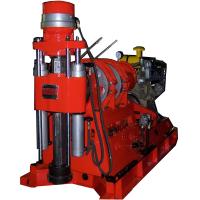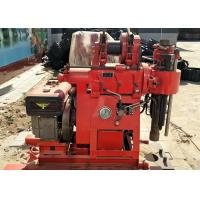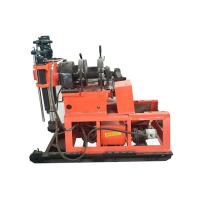Manufacturer Of Soil Testing Drilling Rigs For Environmental
Monitoring
ST30 impact drill rubber track drilling rig
The ST30 impact drilling rubber track drilling rig It is a
lightweight and multifunctional micro engineering drilling rig with
high torque, used for geological exploration sampling in industries
such as industrial and civil construction, bridges, railways,
highways, and hydropower. Its structure is compact, small in size,
light in weight, with two speed changes, easy to transport and
move, and can achieve complete drilling and sampling. The diameter
of the borehole is 46-91 millimeters, and the depth of the borehole
varies under different conditions, such as 15-20 meters for soil
layer with a diameter of 91; When the rock diameter is 91, it is
10-15 meters. The drilling angle is 0-90 °, the drilling torque is
120N. m, and a voltage of 380V is used
ST30 Borehole Drilling Machine Technical Data:
| Technical Parameter | Details |
| Drilling Diameter | 42-146mm |
| Drill Depth | 30m |
| Maximum Lifting Capacity | 1500kg |
| Tower Height | 6m |
| Average Speed of Winch | 0.24m/s, 0.57m/s, 1.48m/s |
| Rotary Table Diameter | 150mm |
| Rotary Speed | 18r/min, 44r/min, 110r/min |
| Drilling Rig Diesel Engine Power | 18HP |
| Weight | 1.3T |
| Dimensions (Length×Width×Height) | 3.5m×1.7m×1.8m |
Performance characteristics
It can be applied to environmental monitoring and protection, and
can use impact drilling and spiral drilling techniques to quickly
obtain reliable underground information without damaging the
underground soil structure. It is possible to obtain undisturbed
soil samples from the surface to deep layers, and different drill
rods and drilling tools can also be used to set up small-diameter
groundwater observation wells. During the drilling process, mud and
other cleaning media are not used, and the waste generated during
drilling is 70% -80% less than conventional drilling. It has the
characteristics of high construction efficiency, good fidelity of
rock and soil samples, less environmental pollution, compact
structure, good maneuverability, and construction safety.
Proper use and maintenance of impact drilling environmental
sampling rigs can not only ensure operational efficiency and
sampling accuracy, but also extend equipment life and reduce the
risk of failure. The following are specific operation guidelines
and maintenance points:
1, Preparation before use
1. Site survey and equipment inspection
Terrain assessment: Ensure that the drilling rig parking area is
flat and solid, and avoid working on slopes or soft ground to
prevent equipment from tilting or sinking. If the ground is uneven,
use padding or sleepers to level the machine body.
Power and gas source inspection:
Fuel powered models: Check the diesel/gasoline volume and oil level
to ensure that the fuel grade matches the ambient temperature (such
as using low pour point diesel in winter).
Motor type: Confirm that the power supply voltage is stable (e.g.
QZ-30S requires 380V voltage), and that the cable is not damaged or
has any potential leakage hazards.
Pneumatic model: Connect the air compressor, check if the air
pressure meets the equipment requirements (usually 0.6-1.0MPa), and
ensure there is no air leakage in the gas pipeline.
Preparation of drilling tools and accessories:
Select appropriate drilling tools based on the type of formation
(such as spiral drills for soil layers and impact drilling tools
for fractured layers), check the wear of the drill bit, and ensure
that the inner wall of the sampling cylinder is smooth and free of
deformation.
Prepare commonly used tools such as wrenches and screwdrivers, as
well as spare sealing rings, O-rings, and other vulnerable parts.
2. Installation and commissioning
Modular assembly: Install the mast, power head, drill pipe and
other components in the order specified in the manual, ensuring
that the bolts are tightened (using a torque wrench to tighten to
standard torque) and that all interfaces are well sealed.
No load trial operation:
Start the power system, run at low speed for 5-10 minutes, and
observe whether the instrument panel parameters (such as oil
pressure, air pressure, and speed) are normal.
Idle the drilling tool, check if the rotation direction is correct
(usually clockwise), if the impactor moves smoothly, and if there
are any abnormal noises.
Alignment and verticality calibration:
Use a compass or laser level to adjust the verticality of the
drilling rig, ensuring that the drilling deviation is ≤ 1% (special
projects require calibration according to design requirements).
Align the sampling point markings, fix the drilling rig base, and
if necessary, use ground anchors or counterweights to enhance
stability.
























